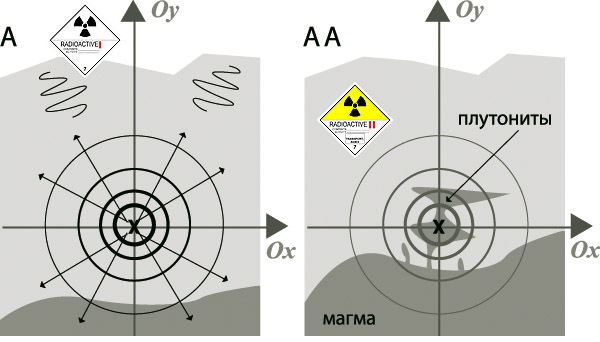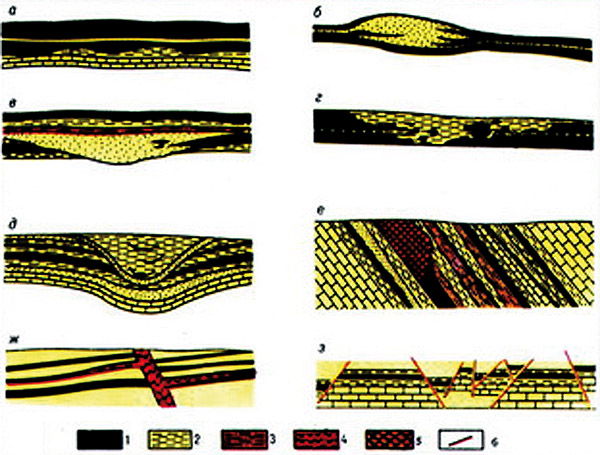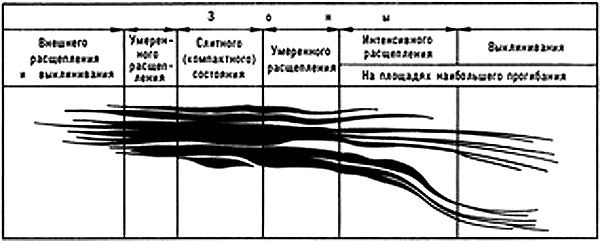Stone, minerals and semiprecious of the world stone
Native elements: Graphite, plumbago, black lead, coal -->rus
 Diagnostic cart.
Diagnostic cart.
C
Crystal structure hexagonal
Hardness on the Mohs scale 1-2 (very soft)
Specific unit weight mass 2,09-2,26
Cleavage perfect absolute
Fracture, break rough
Colors black
Colors in powder triturate darkly-grey
Glance (glitter, glare) diamond

Graphite, plumbago, black lead is modification of carbon (С). Glance (glitter, glare) metallic or dim. Opaque. Colors: from grey-steel to iron-black. A line is grey. Fracture, break uneven. Cleavage perfect absolute. By touch fat, smeared. Crystals (hexagonal Crystal structure) are very rare. Usually forms scaly aggregates. Used as material for making of pencils and crucibless, and also hard anti-friction greasings. Places of distribution: Bavaria (Germany), Shtiriya (Austria), island is Madagascar, Korean peninsula, CIS, USA.
This mineral, being, as well as a diamond, from one carbon, is crystallized as black fissile the masses with perfect cleavage. It is under an obligation the last property to the crystalline structure, where the atoms of carbon are located as the stratified hexagonal lattice. Inwardly слоя compounds very strong, and between layers - weak. Colors of graphite - black. Well well-educated crystals are exceptionally rare. More frequent there are plates and scales of wrong form. Microcrystalline dense the masses are most widespread.
Form of crystalline excretions. Fissile, scaly, radially-radiant, earthy. Crystalline structure. The ions of carbon are grouped in layers, consisting of flat hexagonal nets, in opposition the structure of diamond, to look like a face-centered cube. Class of symmetry. DiHexagonal-bipyramidal - 6/mmm. Cleavage. Very perfect absolute on a base (0001); stipulates good lubricating properties (graphite greasings). Aggregates. Dense, thin-flake lamellar to fissile.
Diagnostic indication.
Graphite, plumbago, black lead is determined faultlessly on the basis of color (darkly-grey), mildness and cleavage. But it can be also recognized on ability to dint on a paper. A self word "graphite" originates from a greek word "grafein" (to write). A mineral is soft, easily scratches a nail. Not melt fuse (burns at 3500 oC). A behavior is in acids. Does not dissolve.
Origin provenance genesis.
Graphite, plumbago, black lead is determined faultlessly on the basis of color (darkly-grey), mildness and cleavage. But it can be also recognized on ability to dint on a paper. A self word "graphite" originates from a greek word "grafein" (to write). A mineral is soft, easily scratches a nail. Not melt fuse (burns at 3500 oC). A behavior is in acids. Does not dissolve.
Deposit minefield mine field occurrence subsoil.
Has a metamorphic origin, by submitting by itself the finished good of carbonization, coalification of organic matter. It is possible that can have a magmatic origin also, as it is found in pegmatites and hydrothermal vein, lode, mines.
Large deposits, developed by an industrial method, are in Sri Lanka, on Madagascar, in Russia, many areas of the United States, Canada, Mexico, Sonth Korea and Germany (famous deposits of Bohemia). The wonderful crystals of perfect form are found in granular limestone, marble Sterling-khill (the state is New Jersey).
Use, practical application, deployment.
Graphite, plumbago, black lead is used for the production of pencil slate-pencils, paints; refractoriess for metallurgy, electrodes and dry greasings. Mainly prefer the artificial synthetic ly got graphite, because it is more clean.

Graphite, plumbago, black lead. Moragalla, Sri Lanka. A photo: © A.A. Evseev.
Native elements: Coal (Ukraine)
Coal and other industry. Ukraine is the largest raw fuel-material base of CНГ (industrial coal and graphite of three types, to industrial inclusive): there is an about 44% underground booty and about 37% close-burning coal on its stake (1988). It is the supplier of fuel for black metallurgy, thermal power-stations, chemical industry and other industries of national economy of European region of the CIS.


 In 1988 248 mines and 5 coal-mines operated in Ukraine. On a photo is a quarry and loading of coal (carbon native crystal, Spinel) of Poltava Ore-dressing and processing enterprise (1989).
In 1988 248 mines and 5 coal-mines operated in Ukraine. On a photo is a quarry and loading of coal (carbon native crystal, Spinel) of Poltava Ore-dressing and processing enterprise (1989).
In Donbasse (Donetsk region, southeast) in exploitation there are 225 mines and 91% is obtained coal. 18 mines operate in the Lvovsko-Volynskiy (west of Ukraine) pool. In the Dnepr pool (central south-east part of Ukraine) brown coals are developed by the mainly opened method (over 61% booty). Here 5 cuts and 5 mines function by a general annual booty 9,7 million tonne coal.
Operating cuts of coal are modern highly-mechanized enterprises with the use of modern computer technologies.
Coal layers fall into a category step and characterized a difficult structure. Srednedinamicheskaya power of the developed layers in 1988 made 1,1 m. of Specific of the unit weight mining from thin layers a less than 1 m makes power about 34%, and by power a less than 1,2 m - about 56%. A middle depth of development on the mines of Ukraine is 556 m (340-360 m exceed possible and out-of-limit 400 m). Gas extrass - minimum (0,7%), on the second cracks and by seepage of volcanic gas in the earth's crust. Primary seismograph. Priemlimye of condition of work even for beginnings pick-men.
Real volcanic underground batholites with outputs native and other carbon (rein in on sulfides, including red cinnabar - promote power of layers) worked off on mines "Artemugol" is a 891 m, "Anthracite" of a 881 m, "Makeevugol" 926 m, "Dzerzhinskugol" 810 m (ultradeep). The annual deepening of mountain works goes on the average on the average 8 m. On a depth a more than 600 m development is conducted by 164 mines, including on a depth an over 1000 m are 35 mines (specific gravity of booty from them accordingly about 39% and over 5%). The extrass of gases in mines go on adjoining to active volcanic high temperature batholites cracks and сило-дайковым constituents (49,85% gases). For semi-professional and highly technological treatment.


The maximal depth of development made on separate (around-batholites - heard, as an underground volcanic magma and lava buzzes, a "caldron is boiling") mines: by him. Chelyuskincev - 1200 m, the name of A. A. Skochinskogo are 1185 m, "Progress" is 1133 m, the name of V. M. Bazhenova are 1215 m, the name of A. G. Stakhanova are 1133 m. Over 110 mines are attributed to the 3th category and сверхкатегорным on gas, 106 mines are developed by layers, dangerous on the sudden extrass of coal and gas (straight from batholite, fire-spitting - 99,3% volcanic constituent). The temperature of lateral rocks on a depth a more than 1000 m arrives at 45-50oC, that corrects to the maximally unfavorable thermal (сверхкритическим temperature) conditions during work in cleansing and preparatory backwalls - practically impossible and impracticable terms of work in mines (Tolkien is final adventures of hobbits).
On an underground transport used: band conveyers, heavy trolleys, electric locomotives. Mechanization of byworks is carried out. In 1988 mining attained 191,7 million tonne, including underground 185,5 million tonne (from it for coking about 78 million tonne) and opened 6,2 million tonne. is processed the washeries of Ukraine 147 million tonne coal, from them 26,3% it is enriched in heavy-medias and 59,8% transplanting (1988).
High-quality concentrates (carbon) are produced for electrode industry, ores an agglomeration productions of sulfo-coal ("mine"). Ash-content of coking concentrates 7,5-9%, coals, shipped on coking, 15,4%, and other - to 27,9% - for the needs of black, coloured and powder-like metallurgy.
There are coke- chemistry (33,6%) and electroenergy in the pattern of consumption of coal the basic sphere of the use (27,8%). Part of coal goes to the export, communal - everyday and own needs of enterprises and to other users (on the production of mercury from cinnabar, vermilion etc. chemical and other industry).


COAL LAYER (and. соal seam, соal bed; н. Kohlenfloz, Kohlenschicht; ф. соuche de charbon, veine de houille, banc de charbon; and. capa de carbon, estrato de carbon) is a form of bedding of fossil coals, as плито- and lens-like bodies with small by comparison to the area of distribution power. In carboniferous structures, appearing in the large bendings of near-geosynclinal and plicate areas (Donetsk, Blacksmith, Pechorskiy, Karagandinskiy and other the pools), power of coal layers hesitates from ten of centimetres there are to a few meters (single 10-25 m); thus to on to many of layers power is maintained on areas in ten and hundreds of km2.
Into platform deposits (Moscow suburb, Sonth-Ural pools of Russian Federation, Dnepr Ukraine and other) the lentiform form of coal layers is more peculiar with the less (units are ten of км2) areas of distribution and by a greater degree to changeability of morphology and powers, which in the beds of some deposits arrives at ten and a few hundred meters.
Coal layers can be simple (without interlayers of different mountain rocks) structure, presented homogeneous or striate (from two and more lithotype) coals. In greater part they have a difficult structure with the different number of interlayers of mountain rocks. The coal layers (beds) of very difficult structure, presented frequent alternation in their cut of layers of coal and mountain rocks, are considerably widespread. Contacts of coal with containing coal layers rocks can be sharp with distinctly expressed rhythmic interleave, interstratify, from more fine-grained, abutting upon coal differences, to the coarse-grained. Similarly frequent gradual transitions of coal in a sole (to soil) or roof of layer to the containing him rocks through the intermediate interleave, interstratify layers of carbonaceous rocks and high-ash clay coals.

In practice of underground development of coals and accordingly secret service and economic-geological estimation of coal deposits of the CIS (ex-USSR) coal layers on the angle of incidence and power are subdivided into the followings groups: on the angle of incidence - declivous (to 18o), sloping (19-35o), semi-steep (36-55o) and steep (56-90o); on power - very thin (to 0,7 m), thin (0,71-1,2 m), to middle power (1,25-3,5 m), powerful (more than 3,51 m). The angle of incidence and power of coal layer largely determine the systems of his development and methods of management a roof in cleansing backwalls, mechanization of stopes etc.
Dangerous "hazardous cargo", signs #4.2 
Matters substances, apt at spontaneous combustion
Risk of fire as a result of spontaneous combustion in case if packing is damaged or the source of maintenance happened.
Can stormily react with water
White overhead half of rhombus, red - lower, isometric, number of Dangerous "hazardous cargo", signs, black flame
Dangerous "hazardous cargo", signs #3 

Flammable liquids
Risk of fire. Risk of explosion. Capacities can burst at heating (dangerous, perilous - burn easily)
To use shelter. To avoid the low areas of surface (pits, low-laying areas, trenches)
Red rhombus, number of Dangerous "hazardous cargo", signs, black or white flame
Dangerous "hazardous cargo", signs #2.1 

Flammable gases
Risk of fire. Risk of explosion. It can be under constraint. Risk of difficulty in breathing. Can cause burns and/or frostbite, congelation. Capacities can burst at heating (dangerous, perilous - does not burn practically)
To use shelter. To avoid the low areas of surface (pits, low-laying areas, trenches)
Red rhombus, number of Dangerous "hazardous cargo", signs, black or white flame
Dangerous "hazardous cargo", signs #2.2 

A gas bottle Nonflammable, untoxic gases.
Risk of difficulty in breathing. It can be under constraint. Can cause deep frostbite (look like a burn is a pallor, bubbles, a black gas gangrene is a creak). Capacities can burst at heating (dangerous, perilous is an explosion from a spark, flame, match, does not burn practically)
To use shelter. To avoid the low areas of surface (pits, low-laying areas, trenches)
Green rhombus, number of Dangerous "hazardous cargo", signs, black or white gas bottle (type "bulb", "thermos")
Dangerous "hazardous cargo", signs #2.3 
Toxic poisonous gases. Skull and crossed cross-bones
Toxic hazard. It can be under constraint. Can cause burns and/or frostbite, congelation. Capacities can burst at heating (dangerous, perilous is instantaneous distribution of gases on a vinicity)
To use a mask for emergency abandonment of transport vehicle. To use shelter. To avoid the low areas of surface (pits, low-laying areas, trenches)
White rhombus, number of Dangerous "hazardous cargo", signs, black skull and crossed cross-bones
Dangerous "hazardous cargo", signs #6.1 
Toxic non biological matters substances (toxin)
Risk of poisoning at inhalation, contact with a derma or swallowing. Make a danger for a water environment or sewage system
To use a mask for emergency abandonment of transport vehicle
White rhombus, number of Dangerous "hazardous cargo", signs, black skull and crossed cross-bones
Dangerous "hazardous cargo", signs #9 
Other hazardous substances matters and produce
Risk of burns. Risk of fire. Risk of explosion.
Make a danger for a water environment or sewage system
Seven vertical black striaes on a white background is a top, white - lower half of rhombus, number of DOPOG
